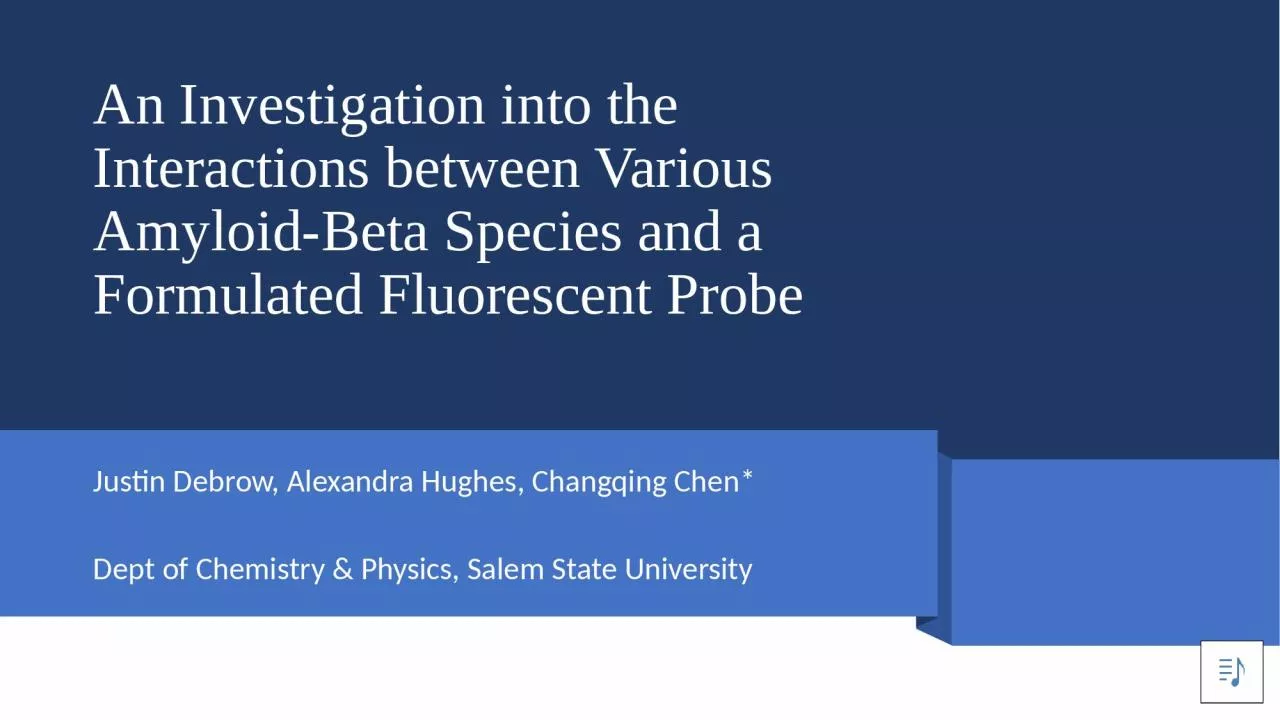

Justin Debrow Alexandra Hughes Changqing Chen Dept of Chemistry amp Physics Salem State University Outline Introduction Alzheimers Disease AD is a progressive neurodegenerative disorder that affects approximately 57 million US citizens ID: 1034929
Download Presentation The PPT/PDF document "An Investigation into the Interactions b..." is the property of its rightful owner. Permission is granted to download and print the materials on this web site for personal, non-commercial use only, and to display it on your personal computer provided you do not modify the materials and that you retain all copyright notices contained in the materials. By downloading content from our website, you accept the terms of this agreement.
1. An Investigation into the Interactions between Various Amyloid-Beta Species and a Formulated Fluorescent Probe Justin Debrow, Alexandra Hughes, Changqing Chen*Dept of Chemistry & Physics, Salem State University
2. Outline
3. IntroductionAlzheimer’s Disease (AD) is a progressive neurodegenerative disorder that affects approximately 5.7 million US citizens.The cause of AD is theorized to be related to the accumulation of various Amyloid-Beta species (Aβ) in the brain. Curcumin, natural polyphenolic compound, has been shown to have an affinity to Aβ, which can serve as a fluorescent probe.This research investigated the fluorescence of mixtures of Aβ species and curcumin at different Aβ concentrations. Figure 1: Aβ 1-42 amino acid sequence with highlighted area of interaction with curcuminFigure 2: Molecular structure of curcumin, the fluorescent probehttps://arcpointelkgrovevillage.wordpress.com/2014/01/08/the-connection-between-cholesterol-alzheimers-disease/
4. Preparation of A𝛽-42 and Curcumin testing solutions:5% curcumin in phosphate-buffered saline (PBS) was used as the fluorescent probe. 22.2 µM A𝛽-42 aggregates, 22.2 µM A𝛽-42 oligomer and 22.2 µM A𝛽-42 monomer testing solutions were prepared according to reported procedure.Fluorescence measurements were performed using a Fluorescence Spectrophotometer.A𝛽-42 aggregates images were captured under a Fluorescence Microscope.
5. Fluorescence Microscopy ResultsIn the absence of the curcumin solution, the A𝛽 aggregates were indistinguishable from the background.In the presence of the curcumin, the A𝛽 aggregates are clearly visible. Figure 3: 10 µL of Aβ Aggregate testing solution with (right) and without (left) 10 µL of curcumin solution captured by a fluorescence microscope
6. Fluorescence of Curcumin in the Presence of 20µL Aβ-42At the lowest Aβ concentration level (20 µL), all curcumin-Aβ-42 species mixtures produced relatively similar fluorescence emissions and varied insignificantly from one another. Figure 4: Fluorescence of Curcumin in the Presence of 20µL Aβ-42.
7. Fluorescence of Curcumin in the Presence of 100µL Aβ-42Comparing the spectra of the curcumin-monomer and the curcumin-oligomer mixtures, the latter showed a relatively small blue-shift of 15 nm.Curcumin-aggregate mixture displayed a much smaller fluorescence intensity. Figure 5: Fluorescence of Curcumin in the Presence of 100µL Aβ-42.
8. Fluorescence of Curcumin in the Presence of 200µL Aβ-42Fluorescence of the curcumin-aggregate mixture was quenched. Emission peak was blue-shifted.Emission peak of the curcumin-oligomer mixture was blue-shifted and had a slight decrease in peak intensity.Figure 6: Fluorescence of Curcumin in the Presence of 200µL Aβ-42.
9. Fluorescence of Curcumin in the Presence of 400µL Aβ-42Curcumin in the presence of 400 µL of Aβ species showed similar fluorescence spectra to the 200 µL Aβ species.Figure 7: Fluorescence of Curcumin in the Presence of 400µL Aβ-42.
10. Comparison of Spectra
11. ConclusionCurcumin interacts differently with soluble monomer, oligomer and insoluble aggregate Aβ species. The fluorescence peak intensities and peak positions changed with the type of Aβ species as well as their concentrations.When there is a greater amount of Aβ species present, the change in fluorescence intensity and shifting are more evident.Under a fluorescence microscope, Aβ aggregates showed no fluorescence under blue light irradiation. However, upon the addition of curcumin, Aβ aggregates became visible.
12. References[1] Xueli Zhang, Yanli Tian, Can Zhang, Xiaoyu Tian, Alana W. Ross, Robert D. Moir, Hongbin Sun, Rudolph E. Tanzi, Anna Moore, Chongzhao Ran. “NIRF imaging amyloid and monitoring therapy.” Proceedings of the National Academy of Sciences Aug 2015, 112 (31) 9734-9739[2] Maresova, P.; Tomsone, S.; Lameski , P.; Madureira, J.; etal. Technological Solutions for Older People with Alzheimer’s Disease: Review. Curr. Alzh. Res. 2018, 15.[3] Ran, C.; Xu, X.; Raymond, B.R.; Ferrara, B.J.; Neal, K.; Bacskai, B.J.; Medarova, Z.; Moore, A. Design, Synthesis, and Testing of Fifluoroboron-Derivatized Curcumins as Near-Infrared Probes for In Vivo Detection of Amyloid-β Deposits. J. Am. Chem. Soc. 2009 (131) 15257-15261[4] Alzheimer’s Disease: Facts & Figures. https://www.brightfocus.org/alzheimers/article/alzheimers-disease-facts-figures (accessed Apr 18, 2020).[5] Sou, Keitaro et al. "Loading Of Curcumin Into Macrophages Using Lipid-Based Nanoparticles". International Journal Of Pharmaceutics, vol 352, no. 1-2, 2008, pp. 287-293. Elsevier BV, doi:10.1016/j.ijpharm.2007.10.033.
13. AcknowledgementsWe would like to thankDean Gail Gasparich for providing funding for our researchSalem State University Chemistry & Physics Department for the continuous supportProf. Jason Brown for training on fluorescence microscope Prof. Jayashree Ranga for her support